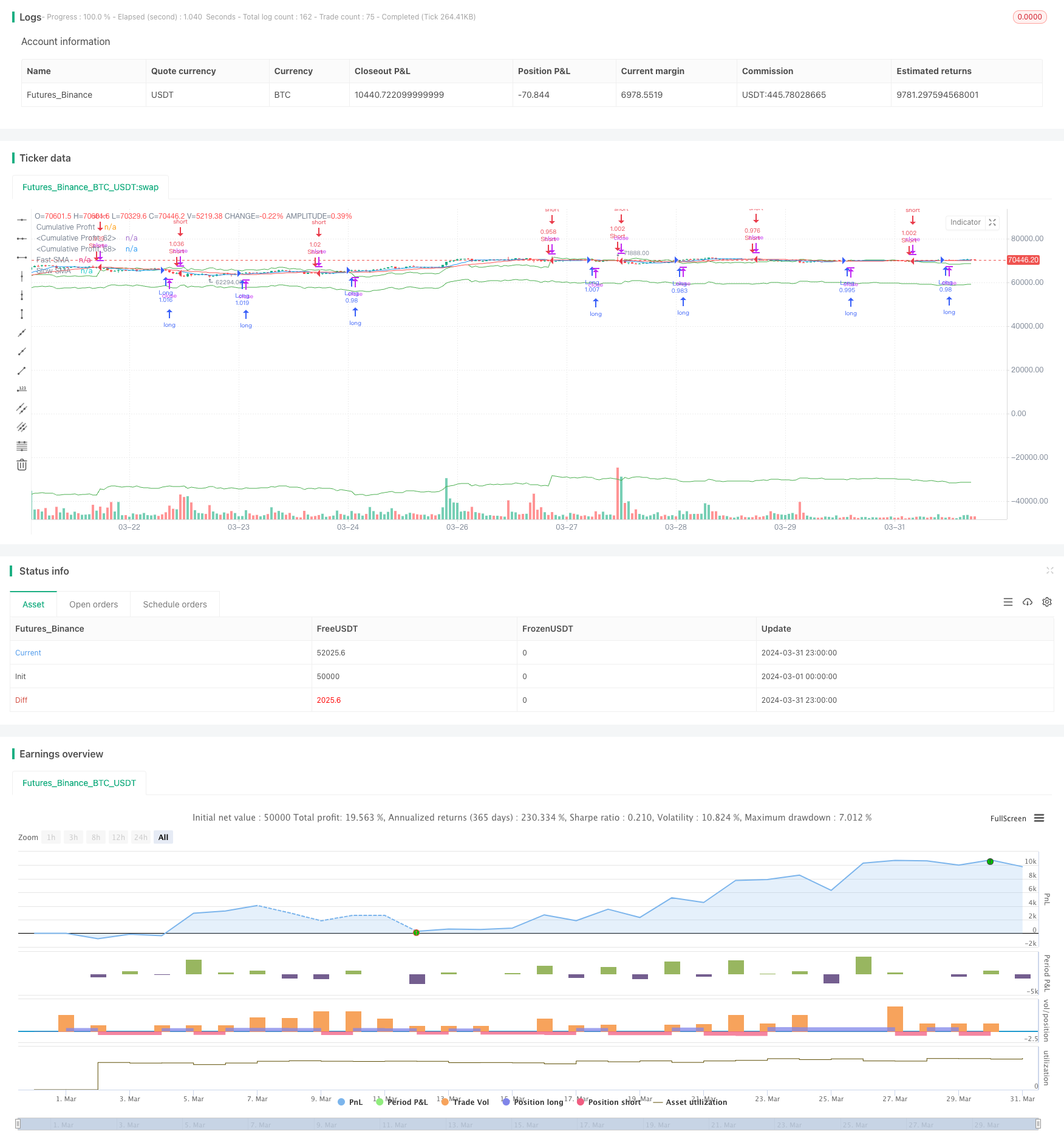
概述
该策略是一个基于简单移动平均线(SMA)交叉的多头/空头策略。它使用两条不同周期的SMA来生成交易信号。当快速SMA从下方向上穿过慢速SMA时,生成多头信号;当快速SMA从上方向下穿过慢速SMA时,生成空头信号。该策略使用了复利的概念,根据当前账户余额和累积利润动态调整仓位大小。这使得账户余额随着时间的推移而增长,从而提高了策略的盈利能力。
策略原理
该策略的核心原理是利用SMA交叉生成交易信号。SMA是一种趋势跟踪指标,通过对过去一段时间内的收盘价进行平均,来确定价格的总体方向。通过使用两条不同周期的SMA,策略可以捕捉到市场趋势的变化。当快速SMA上穿慢速SMA时,表明上涨趋势可能正在形成,因此策略进入多头;相反,当快速SMA下穿慢速SMA时,表明下跌趋势可能正在形成,因此策略进入空头。
策略使用了复利的概念来管理仓位大小。它根据当前账户余额和累积利润来计算仓位大小。这意味着随着账户余额的增长,策略会相应地增加仓位大小,从而最大化利润潜力。通过动态调整仓位大小,策略能够充分利用账户增长的优势。
策略优势
简单易懂:该策略基于SMA交叉,是一个简单易懂的趋势跟踪策略。它不需要复杂的市场时机把握或主观判断,使得策略易于实施和管理。
趋势跟踪:通过使用SMA交叉,该策略能够有效地捕捉市场趋势。它可以在上涨趋势中进行多头交易,在下跌趋势中进行空头交易,从而最大化利润潜力。
动态仓位管理:策略采用了复利的概念来管理仓位大小。通过根据账户余额和累积利润动态调整仓位大小,策略可以充分利用账户增长的优势,提高盈利能力。
适应性强:该策略可以应用于各种市场和资产类别,如股票、外汇、商品等。它的简单性和适应性使其成为一个通用的交易策略。
策略风险
市场风险:该策略依赖于市场趋势的持续性。在市场波动或趋势反转的情况下,策略可能会遭受损失。突发事件、经济数据发布等因素都可能导致市场走势的突变,对策略造成不利影响。
参数风险:策略的表现取决于SMA的周期选择。不同的周期组合可能会产生不同的结果。选择不当的参数可能导致策略表现欠佳或错失交易机会。
过度交易:在市场波动期间,频繁的SMA交叉可能导致过度交易,增加交易成本和滑点,从而影响策略的整体表现。
复利风险:虽然复利可以提高策略的盈利能力,但它也放大了损失的风险。在连续亏损的情况下,账户余额可能会快速缩水,从而限制策略的复苏能力。
策略优化方向
参数优化:对SMA的周期进行优化,找到最佳的参数组合,以提高策略的表现。可以使用历史数据进行回测,并使用优化算法如网格搜索或遗传算法来寻找最优参数。
风险管理:引入风险管理措施,如止损和止盈,以限制单次交易的损失和保护利润。可以根据市场波动性动态调整止损和止盈水平,以适应不同的市场条件。
趋势过滤:在SMA交叉之外,引入其他趋势确认指标,如MACD或ADX,以过滤掉假信号和提高信号质量。只有当多个指标同时确认趋势时,才进行交易,以提高策略的可靠性。
仓位管理优化:优化复利策略的仓位管理规则,如引入风险控制措施,限制单次交易的风险敞口。可以考虑使用凯利公式或固定风险百分比来确定每笔交易的仓位大小,以平衡风险和回报。
总结
该策略是一个基于SMA交叉的趋势跟踪策略,采用了复利的概念来管理仓位大小。它的优势在于简单易懂、趋势跟踪能力强、动态仓位管理和适应性强。然而,它也面临市场风险、参数风险、过度交易和复利风险等挑战。为了改进策略,可以考虑参数优化、引入风险管理措施、趋势过滤和优化仓位管理规则。通过不断优化和改进,该策略有望在各种市场条件下取得稳定的表现。
/*backtest
start: 2024-03-01 00:00:00
end: 2024-03-31 23:59:59
period: 1h
basePeriod: 15m
exchanges: [{"eid":"Futures_Binance","currency":"BTC_USDT"}]
*/
//@version=5
strategy("Umesh SMA Crossover Strategy", overlay=true)
// Input parameters
fast_length = input.int(9, title="Fast SMA Length")
slow_length = input.int(21, title="Slow SMA Length")
// Calculate SMAs
fast_sma = ta.sma(close, fast_length)
slow_sma = ta.sma(close, slow_length)
// Plot SMAs
plot(fast_sma, color=color.blue, title="Fast SMA")
plot(slow_sma, color=color.red, title="Slow SMA")
// Strategy logic
longCondition = ta.crossover(fast_sma, slow_sma)
shortCondition = ta.crossunder(fast_sma, slow_sma)
// Initialize cumulative profit with netprofit
var float cumulative_profit = na
if (na(cumulative_profit))
cumulative_profit := strategy.netprofit
// // Initialize starting balance
// var float starting_balance = na
// if (na(starting_balance))
// starting_balance := strategy.equity
// Initialize starting balance
var float starting_balance = na
if (na(starting_balance))
starting_balance := 100000.0 // Initial balance
// Calculate profit or gains
if (strategy.opentrades != 0)
cumulative_profit := strategy.netprofit + (strategy.equity - starting_balance)
// Calculate position size based on current balance and cumulative profit
//position_size = 100000
position_size = starting_balance + cumulative_profit
// Entry conditions
if (longCondition)
strategy.entry("Long", strategy.long, qty = position_size / close)
if (shortCondition)
strategy.entry("Short", strategy.short, qty = position_size / close)
// // Entry conditions
// if (longCondition)
// strategy.entry("Long", strategy.long, qty = 100000 / close)
// if (shortCondition)
// strategy.entry("Short", strategy.short, qty = 100000 / close)
// Plot strategy.equity
plot(strategy.equity, color=color.green, title="Cumulative Profit")
// Print cumulative profit value on chart
label.new(x = bar_index, y = strategy.equity, text = str.tostring(strategy.equity), style=label.style_label_down, color=color.new(color.green, 0), size=size.small)
// Plot cumulative profit
plot(cumulative_profit, color=color.green, title="Cumulative Profit")
// Print cumulative profit value on chart
label.new(x = bar_index, y = cumulative_profit, text = str.tostring(cumulative_profit), style=label.style_label_down, color=color.new(color.green, 0), size=size.small)
// Plot cumulative profit
plot(position_size, color=color.green, title="Cumulative Profit")
// Print cumulative profit value on chart
label.new(x = bar_index, y = position_size, text = str.tostring(position_size), style=label.style_label_down, color=color.new(color.green, 0), size=size.small)